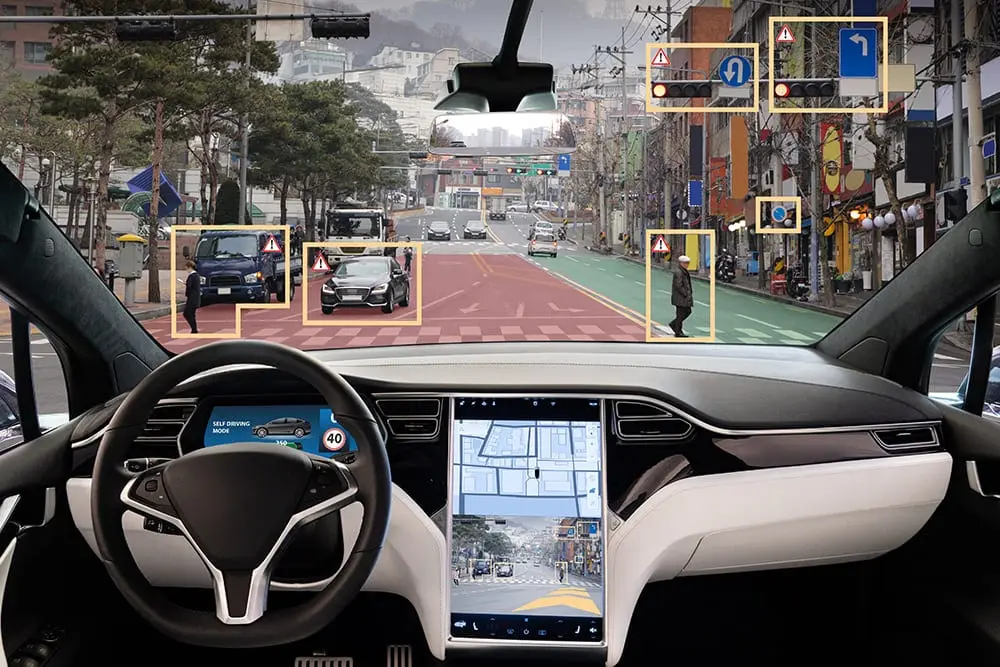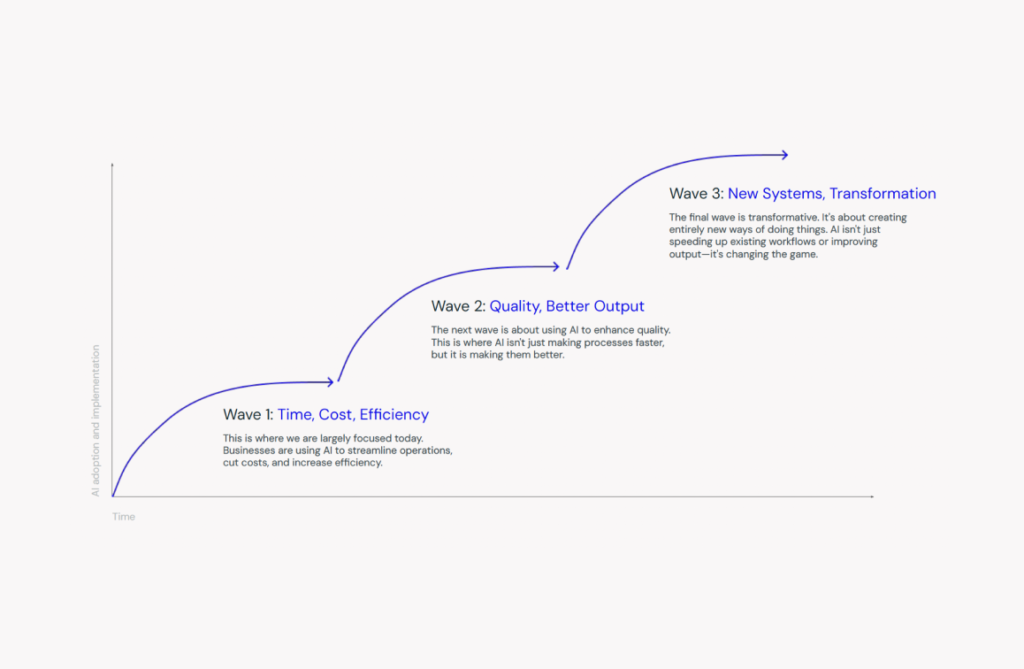3 archetypes: how companies approach AI adoption
Laura Stevens
Managing Director of Data & AI
As organizations navigate the AI revolution, we see three distinct AI adoption archetypes emerging. Each represents a different approach to leveraging AI, whether as a growth engine, an enterprise-wide transformation enabler, or a deep functional enhancement.
1. Outward AI: AI as a revenue generator (AI as a product/service)
These companies place AI front & center in their business or operating model, using it as a core differentiator/growth driver. AI isn’t just a supporting tool, it’s a core product or a revenue enabler.
Characteristics
- AI-powered products, services, or business models.
- AI as a monetizable asset—from AI-powered subscriptions to new data-driven services.
- Heavy investment in proprietary AI capabilities and R&D.
Examples of AI as a revenue generator

Spotify
AI-driven personalized playlists and audio discovery models directly impact engagement and subscription revenue.

Tesla
AI-powered autonomous driving as a central value proposition.

OpenAI
AI-based GPT models offered as a core product.

Netflix
AI-powered content recommendation drives customer retention and revenue.
2. Holistic AI: AI as an enterprise-wide transformation engine
Organizations in this category view AI as a cross-functional enabler, embedding it across all business units and operations to drive efficiency, resilience, and decision-making.
Characteristics
- AI-driven automation and efficiency across multiple domains.
- Focus on real-time data, predictive analytics, and proactive decision-making.
- AI used to enhance resilience, adapting dynamically to changing business conditions.
Examples of AI as an enterprise-wide transformation engine

Walmart
AI-driven supply chain optimization, inventory management, and dynamic pricing.

Amazon
AI integrated across logistics, personalization, fraud detection, fulfillment centers.

Shell
AI-powered predictive maintenance, drilling optimizations, energy efficiency initiatives.

Unilever
AI adoption across marketing, R&D, and sustainable sourcing.
3. Deep AI: AI embedded in a specific domain
Rather than applying AI broadly, these companies go deep, embedding AI into one key function or business area where it can drive maximum impact.
Characteristics
- AI is highly specialized within a key operational area.
- Strong integration with industry-specific workflows or customer touchpoints.
- AI-driven transformation focused on single domain vs enterprise-wide implementation.
Examples of AI embedded in a specific domain

Klarna
AI-powered customer service automation, using AI chatbots and predictive insights to enhance user experience.

John Deere
AI-driven precision agriculture, optimizing crop yields with machine learning.

Starbucks
AI-powered loyalty program personalization and real-time menu adjustments.

Lufthansa
AI in customer support and flight disruption management.
Why archetypes matters (and the relevance of different AI approaches)
As AI adoption accelerates, organizations face a critical choice: How will AI shape their future business model and operations? The three AI archetypes – Outward, Holistic, and Deep – provide a strategic lens to help companies clarify their AI ambitions, align investments, and make informed decisions about where and how AI should drive value.
1. Strategic clarity: Matching AI ambition to business goals
Understanding these AI archetypes helps companies answer key strategic questions:
- Is AI a core revenue driver (Outward AI)?
- Should AI be embedded across all functions to enhance decision-making and resilience (Holistic AI)?
- Is the best approach to specialize AI in a specific domain for maximum impact (Deep AI)?
By defining an AI archetype early, organizations can ensure that AI adoption is purpose-driven, not just exploratory.
2. Investment & prioritization: Where to focus resources
- Outward AI companies should prioritize AI R&D, build proprietary models, and monetize AI services.
- Holistic AI companies need to invest in AI infrastructure, cross-functional data sharing, and real-time decision systems.
- Deep AI adopters must optimize AI in a focused domain, ensuring deep integration with business processes.
Without a clear AI strategy, companies risk spreading resources too thin or investing in AI without clear ROI expectations.
3. Operating model alignment: Structuring AI for impact
Each archetype requires different organizational capabilities, governance structures, and AI talent strategies:
- Outward AI needs strong AI innovation teams, product managers, and scalable AI infrastructure.
- Holistic AI requires a company-wide AI governance framework and cross-functional collaboration.
- Deep AI demands deep expertise in one domain, ensuring seamless AI integration into workflows.
Without a structured AI operating model, even the best AI strategies may fail to scale.
4. Competitive differentiation: AI as a market advantage
AI is becoming a key differentiator in nearly every industry.
- Outward AI companies gain a competitive edge by launching AI-powered products/services before competitors.
- Holistic AI adopters win through faster, data-driven decision-making and operational resilience.
- Deep AI organizations create best-in-class AI-driven experiences in their focus area (e.g., Klarna in customer service).
A misaligned AI strategy could mean falling behind industry leaders who use AI more effectively.
5. AI scalability & long-term success
Some companies start with Deep AI and later evolve into a Holistic AI approach.
Others start with Outward AI innovation, then expand AI across internal functions.
Having a clear AI archetype helps organizations plan for future AI expansion, ensuring that today’s investments align with long-term AI maturity.
Key takeaways
- AI is not a one-size-fits-all journey. The three AI archetypes help companies structure AI adoption strategically.
- Clarity in AI ambition prevents wasted investments and accelerates ROI.
- Aligning AI with business strategy ensures scalability and long-term competitive advantage.
- Companies should evolve their AI roadmap based on their chosen archetype – Outward, Holistic, or Deep.
Let’s talk about how you structure your AI adoption.
Managing Director of Data & AI
Laura Stevens, PhD, is the Managing Director of Data & AI, bringing a unique blend of strategic vision, analytical expertise, and leadership acumen. With a background in neuropsychology, business consulting and organizational transformation, she has successfully navigated a career spanning academia, consulting, and industry leadership. As a former VP Data & AI in an international organization, Laura has led large-scale Data & AI teams covering data science, machine learning, data engineering, data governance, and visualization. She is passionate about leading organizations through their data & AI transformation.
laura.stevens@boardofinnovation.com
Keep learning
More resources on AI driven growth
The post 3 archetypes: how companies approach AI adoption appeared first on BOI (Board of Innovation).




